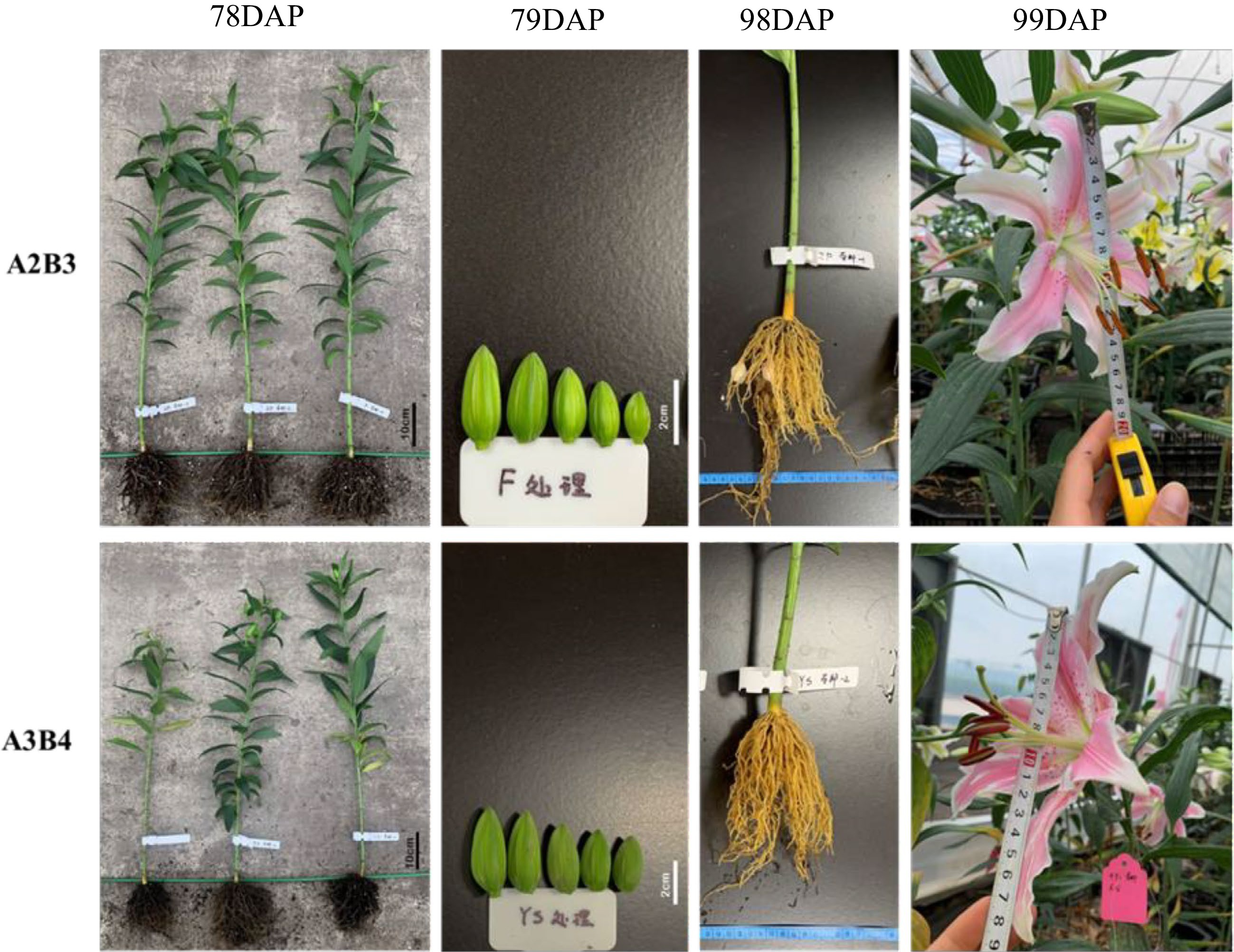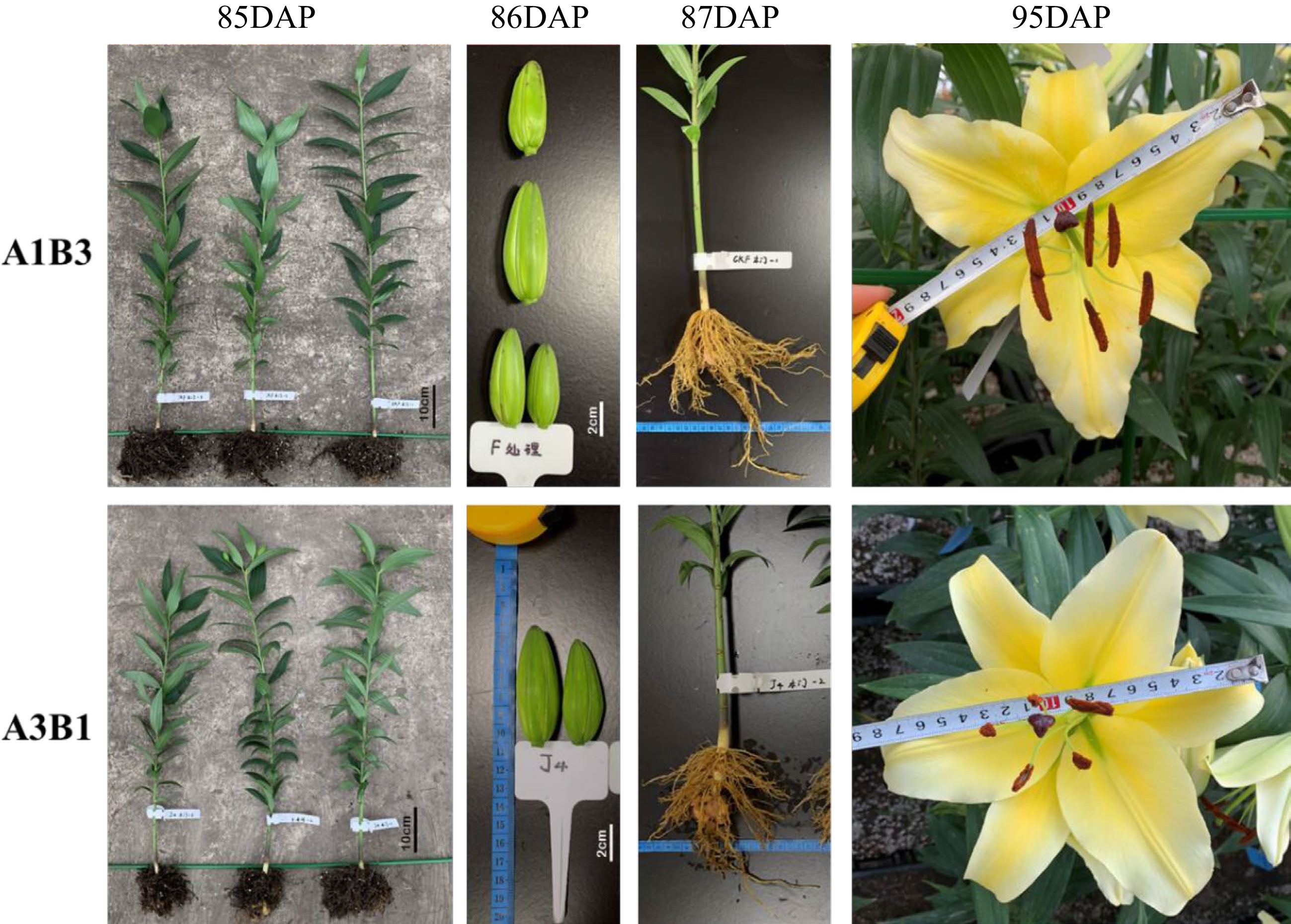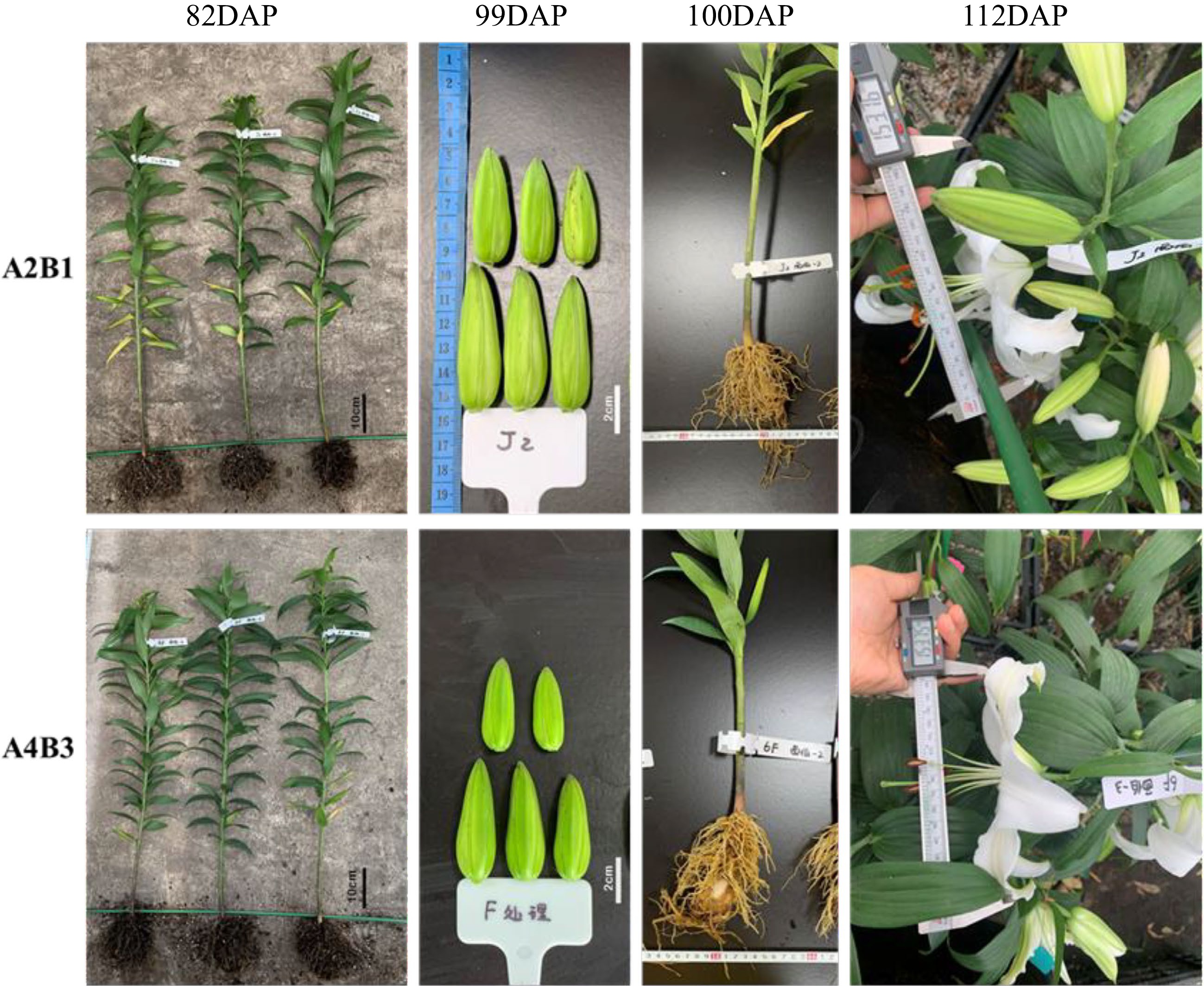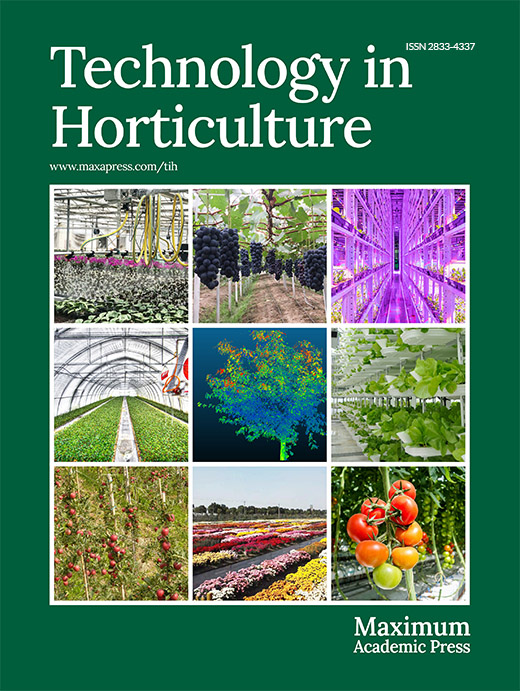HTML
-
Lily (Lilium spp.) is a perennial bulbous flower of the Liliaceae, with large and beautiful flowers, rich colors, and pleasant fragrance[1], it can not only be used as a cut flower, but also be used in landscaping[2−5]. Cut lily is widely cultivated world wide and is deeply loved by people[6], and its consumption is increasing year by year. Lily is a salt-intolerant plant, and it is very susceptible to salt damage if it is improperly fertilized during its growth and development[7]. Lily is not resistant to high temperature[8], the suitable temperature for growth is 22−28 °C, and it will grow poorly if it is higher than 30 °C[9]. Research showed that within a certain range, with the increase of soil nitrogen supply, first class and second class of cut lily flowers yield increase, third class and fourth class of the flower rate reduced, but when the soil nitrogen supply exceeded 65 mg·kg−1, the flowering rate of cut flowers at all levels tends to be stable[10,11]. The application of phosphorus and potassium fertilizers can improve the quality of bulb balls and cut flowers, and nitrogen fertilizers should not be applied alone[12]. The traditional lily planting method is based on experience for production management, and fertilization is arbitrary, resulting in low fertilizer utilization rate during greenhouse cut lily production, and economic benefits are not guaranteed[13,14]. In order to guide farmers and production enterprises to choose appropriate fertilization methods and improve the quality and production efficiency of cut lily, this study was based on three common cut lily varieties to explore the effects of different fertilizer types and fertilization methods on the growth and quality of lily.
MATERIALS AND METHODS -
The test materials were first-generation bulbs purchased from Zhejiang Licai Horticultural Co., Ltd (China). The cultivar were three main domestic cut flower lily varieties 'Conca d'Or' (specification: circumference 14−16 cm), 'Sorbonne' (specification: diameter 16−18 cm), 'Siberia' (specification: circumference 16−18 cm). The substrate adopts domestic northeast peat soil and perlite, peat soil : perlite = 3:1.
Method
-
The experiments were conducted from March 2021 to August 2021 at the Lily Base of Nanjing Agricultural University and the Modern Horticultural Industry Science and Technology Innovation Center of Nanjing Agricultural University, Baguazhou Street, Qixia District, Nanjing City (China). Two factors were set in the experiment: different basal fertilizers (A) and different topdressing fertilizers (B). According to the growth and development of lily plants, fertilization treatment is carried out in two stages: the first stage is the vegetative growth period, from the planting of the bulb to the opening of the top leaves and the flower buds are faintly visible, and the base fertilizer is applied during planting; the second stage is the flower bud expansion stage, into the second stage that is top dressing. A total of three kinds of fertilizers were used, and four treatments of AB were used (Table 1). Among them, the A3B1 treatment was the commonly used fertilization scheme in production. The experiment was divided into 16 treatment groups, with no fertilization as the control (A1B1), and each treatment repeated four times. A 40 cm × 60 cm lily seed ball frame was used as the cultivation container. Two rows were planted in each frame, and six bulbs were planted in each row. The plant-row spacing was 20 cm × 15 cm, and they were randomly arranged[15]. Base fertilizer and top dressing were applied on March 9 and April 28, 2021, respectively, under other normal management.
Table 1. Design of manuring.
Stage I Stage II Basal fertilizer Application amount Top dressing Application amount A1 — B1 — A2 Yangfeng nitrate nitrogen compound fertilizer 2 g/plant B2 Yangfeng nitrate nitrogen compound fertilizer 2 g/plant A3 Yangfeng nitrate nitrogen compound fertilizer 4 g/plant (commonly used in production) B3 YaraMila Compound fertilizer 2 g/plant A4 Yangfeng nitrate nitrogen compound fertilizer 6 g/plant B4 Nopfon macroelement water soluble fertilizer 0.4 g/plant Yangfeng (Hubei Yangfeng Fertilizer Industry Co) N:P:K = 15:15:15; YaraMila N:P:K = 15:15:15, NO3-N 7.5%, NH4-N 7.5%, P2O5 15%, K2O 15%, S 5.1%; Nopfon N:P:K = 19:19:19, N 15%, P2O5 15%, K2O 15%. Determination of indicators
-
In the first stage, the germination rate, plant height, budding rate, and diseased and aphid plant incidence were determined. In the second stage, the plant height, bud number, and flower bud size were determined. The method for determining the germination rate is as follows: the germination rate is counted after half a month of planting, and then every three days until the germination rate of all treatments reaches 70%. The method for determining the plant height is: the plant height of the first stage was determined as the distance from the bulb to the top of the plant, only the plant height of the germinated plants is counted during the measurement, and the average value is calculated. The plant height of the second stage was determined from the bulb to the lower branch of the first bud[16]. The statistics of the budding rate were carried out on the 45th day of planting, when the top leaves opened and entered the stage of flower bud development. Incidence rate and aphid infection rate are the proportion of plants with cumulative disease or aphid infection of each variety in the first period. In the second stage, the plant height, bud number and flower bud size were measured by sample survey method, and 20 plants were selected for each treatment. Bud size refers to the size of the first bud, measuring the length and the radius at the widest point. The experimental data were analyzed by DPSv19.05 (China), and the Duncan new multiple range test and LSD method were used to compare the mean values.
Disease incidence: when the leaves were observed to dry up and drop and the whole plant died, the disease was counted. The incidence rate was calculated by counting the number of diseased plants in a treatment of a certain species throughout the growth of the lily (those counted were marked well to avoid double counting) and dividing it by the number of plants planted in that treatment of that species.
Aphid infection rate: aphid infection was counted when a large amount of aphid damage was observed and coal stains appeared. During the entire growth of lilies, count all aphid-infected plants in a treatment of a variety (mark those counted to avoid double counting), divide them by the number of plants planted in that treatment of that variety, and calculate the aphid infection rate.
Materials
RESULTS -
Accurate growth period prediction is a must in lily production, and a consistent germination rate is a strong guarantee for the same period of listing. It can be seen from Table 2 that for 'Conca d'Or' and 'Siberia', the concentration of basal fertilizer has an impact on germination. The higher the concentration of basal fertilizer, the later the germination, but the final germination rate is not much different. For 'Sorbonne', there was no significant difference in the effect of different basal fertilizer concentrations on the germination rate.
Table 2. Germination rate of each cultivar.
Cultivar Treatment Germination rate on
March 25/cmGermination rate on
March 28/cmGermination rate on
April 1/cmConca d'Or A1 0.5 ± 0.09 a 0.9 ± 0.03 a 0.97 ± 0.03 a A2 0.4 ± 0.06 a 0.9 ± 0.02 a 0.99 ± 0.01 a A3 0.16 ± 0.1 b 0.68 ± 0.06 b 0.86 ± 0.05 b A4 0.05 ± 0.04 b 0.36 ± 0.1 c 0.81 ± 0.09 b Sorbonne A1 0.04 ± 0.05 a 0.32 ± 0.05 a 0.8 ± 0.08 a A2 0.04 ± 0.01 a 0.39 ± 0.08 a 0.81 ± 0.09 a A3 0.05 ± 0.03 a 0.38 ± 0.09 a 0.76 ± 0.05 a A4 0.04 ± 0.03 a 0.38 ± 0.11 a 0.83 ± 0.07 a Siberia A1 0.75 ± 0.02 a 0.97 ± 0.03 a 0.99 ± 0.01 a A2 0.48 ± 0.13 b 0.92 ± 0.08 a 1 ± 0 a A3 0.33 ± 0.11 c 0.9 ± 0.07 a 0.99 ± 0.01 a A4 0.24 ± 0.07 c 0.77 ± 0.07 b 0.98 ± 0.01 a Lower case letters represent significant differences at P < 0.05.
A1 (No base fertilizer); A2 (Yangfeng nitrate nitrogen compound fertilizer 2 g/plant); A3 (Yangfeng nitrate nitrogen compound fertilizer 4 g/plant); A4 (Yangfeng nitrate nitrogen compound fertilizer 6 g/plant).Effects of basal fertilizer on plant height growth of cut lily
-
Lily plant height is one of the important indicators used to measure the quality of lily cut flowers, which affects their economic value[17]. It can be seen from Table 3 that different basal fertilizer concentrations have an effect on the plant height of lily. For the 'Conca d'Or' and 'Siberia' A1 treatments, the growth is the fastest and the plant height is the highest, with significant differences. There was no significant difference in plant height in the early stage of 'Sorbonne', and the plant height in A3 (commonly used production scheme) in the later stage was significantly the lowest, and the difference in other treatments was not significant.
Table 3. Plant height of each cultivar.
Cultivar Treatment Plant height on
March 2/cmPlant height on
March 31/cmPlant height on
April 7/cmPlant height on
April 14/cmPlant height on
April 28/cmConca d’Or A1 0.73 ± 0.09 a 8.28 ± 0.82 a 19.24 ± 1.29 a 34.56 ± 1.35 a 62.89 ± 1.77 a A2 0.41 ± 0.15 b 6.38 ± 0.26 b 17.85 ± 0.43 a 31.89 ± 0.9 b 59.44 ± 1.9 b A3 0.18 ± 0.14 c 4.03 ± 0.58 c 13.54 ± 1.1 b 28.74 ± 0.91 c 53.19 ± 0.94 c A4 0.06 ± 0.04 c 3.35 ± 0.62 c 11.66 ± 0.95 c 29.15 ± 1.67 c 55.66 ± 1.83 c Sorbonne A1 0.02 ± 0.03 a 2.03 ± 0.16 a 6.99 ± 0.3 a 16.98 ± 0.76 b 46.94 ± 0.52 a A2 0.02 ± 0.03 a 2.41 ± 0.56 a 7.63 ± 0.98 a 19.26 ± 0.97 a 49.33 ± 1.5 a A3 0.06 ± 0.05 a 2.03 ± 0.27 a 6.97 ± 0.58 a 17.19 ± 0.81 b 43.95 ± 1.44 b A4 0.02 ± 0.01 a 2.1 ± 0.46 a 7.23 ± 0.93 a 19.93 ± 1.95 a 47.32 ± 2.23 a Siberia A1 1.18 ± 0.23 a 9.11 ± 0.55 a 19.7 ± 0.91 a 33.01 ± 1.29 a 61.93 ± 1.63 ab A2 0.54 ± 0.15 b 8.34 ± 0.42 a 17.8 ± 0.54 b 31.8 ± 0.94 ab 63.59 ± 2.28 a A3 0.61 ± 0.3 b 6.32 ± 0.7 b 16.34 ± 0.98 c 29.68 ± 1.42 c 59.04 ± 3.14 b A4 0.29 ± 0.13 b 6.46 ± 0.43 b 15.82 ± 1.08 c 30.53 ± 1.29 bc 58.99 ± 1.5 b Lower case letters represent significant differences at P < 0.05. Refer to Table 2 for abbreviations. The effect of basal fertilizer on the budding of cut lily
-
The budding time of lily affects the flowering and then affects the time of the cut flowers coming to market. It can be seen from Table 4 that different basal fertilizer concentrations have an impact on the budding of 'Conca d'Or', 'Sorbonne' and 'Siberia'. For the three varieties, the highest budding rates of A2 treatment were 71.81%, 80.85% and 72.4%, respectively. It shows that the application of appropriate amount of basal fertilizer is helpful for budding.
Table 4. The budding rate of different basal fertilizer treatments.
Treatment Conca d’Or Sorbonne Siberia Budding Budding rate Budding Budding rate Budding Budding rate A1 61 33.52% 150 79.37% 115 59.9% A2 135 71.81% 152 80.85% 139 72.4% A3 126 67.02% 141 80.11% 136 70.8% A4 26 13.76% 153 80.53% 115 59.9% Refer to Table 2 for abbreviations. Effects of base fertilizer on aphids and diseases of cut lily
-
During the planting process, virus strains appeared one after another in 'Sorbonne' from budding, and then gradually turned into stem rot, rotten balls and other phenomena, causing the plants to dry up and die. It is speculated that 'Sorbonne' is susceptible to 'leaf burn'[18]. There are also a few cases of infection in 'Conca d'Or'; almost no cases in 'Siberia'. The aphids first attacked 'Siberia', repeatedly attacked, and then extended to the 'Sorbonne', and finally attacked the 'Conca d'Or'. The number of disease and insect strains in the first phase is as shown in Table 5.
Table 5. Disease and aphid incidence of different basal fertilizer treatments.
Treatment Disease incidence Aphid incidence Conca d’Or Sorbonne Siberia Conca d’Or Sorbonne Siberia A1 1.04% 1.56% — 44.51% 2.12% 55.73% A2 1.56% 2.08% — 8.51% 3.72% 45.31% A3 2.08% 8.33% — 3.19% 0.57% 7.81% A4 1.04% 1.04% — 5.29% 0% 40.1% Refer to Table 2 for abbreviations. It can be seen from Table 5 that the number of diseased and aphid infection in 'Conca d'Or', 'Sorbonne' and 'Siberia' is different under different basal fertilizer concentrations. A3 treatment has a higher incidence rate, and A1 treatment has the highest aphid infection rate.
Effects of different fertilization schemes on the quality of cut lily
-
The quality grading indicators of cut lily mainly include: the number of buds, the length of the flower branches, and the size of the flower buds. It can be seen from Tables 6−8 that among the 16 treatments, for 'Conca d'Or', the four indicators of plant height average number of flowers per plant, bud length and flower diameter corresponded to the optimal treatments A1B4, A4B2, A1B3 and A4B1, respectively. For 'Sorbonne', the four indicators of plant height, average number of flowers per plant, bud length and flower diameter corresponded to the optimal treatments A2B4, A2B3, A4B3 and A3B2, respectively. For 'Siberia', the four indicators of plant height, average number of flowers per plant, bud length and flower diameter corresponded to the optimal treatments A2B2, A2B1, A2B4 (and A3B2) and A3B2, respectively. Combining Figs 1−3 and Tables 6−8, it can be found that the comprehensive index A1B3 treatment is the best for 'Conca d'Or', and A3B1 is the worst; A2B3 treatment is the best for 'Sorbonne', and A3B4 is the worst; A2B1 treatment is the best for 'Siberia', and A4B3 is the worst. Among the three varieties, A2B1 treatment (nitrate nitrogen compound fertilizer 2 g/plant as base fertilizer, none topdressing) ranked the top in all indicators except plant height.

Figure 2.
Effects of different fertilization schemes on the quality of ‘Sorbonne’ cut flowers. From left to right, plant height, buds, roots and flowers at different developmental stages. A2B3 (Yangfeng nitrate nitrogen compound fertilizer 2 g/plant, YaraMila Compound fertilizer 2 g/plant); A3B4 (fertilizer 4 g/plant, Nopfon macroelement water soluble fertilizer 0.4 g/plant as topdressing). DAP (days after planting).
Table 6. Effects of different fertilization schemes on the quality of 'Conca d'Or' cut flowers.
Treatment Plant height (cm) Average number of buds
per plantBud size First bud length (cm) First flower diameter (cm) A1B1 73.7 ± 0.92 cde 1.69 ± 0.19 ab 10.75 ± 0.45 abcd 30.56 ± 1.4 abc A1B2 76.33 ± 1.42 abc 1.53 ± 0.17 ab 9.6 ± 0.1 fg 29.55 ± 1.4 abcd A1B3 77.38 ± 0.39 ab 1.47 ± 0.16 ab 11.63 ± 0.2 a 31.57 ± 1.19 ab A1B4 78.23 ± 1.74 a 1.54 ± 0.27 ab 9.83 ± 0.25 defg 26.38 ± 0.46 de A2B1 70.07 ± 1.29 fg 1.66 ± 0.13 ab 11.17 ± 0.95 abc 30.62 ± 2.77 abc A2B2 70.7 ± 2.85 efg 1.66 ± 0.13 ab 10 ± 0.87 defg 27.8 ± 1.47 cde A2B3 74.53 ± 1.58 bcd 1.41 ± 0.06 b 9.94 ± 0.5 defg 27.05 ± 2.25 de A2B4 73.55 ± 2.94 cdef 1.56 ± 0.25 ab 9.65 ± 0.05 efg 25.59 ± 0.01 efg A3B1 65.98 ± 0.91 h 1.63 ± 0.07 ab 9.23 ± 0.35 g 25.38 ± 3.46 e A3B2 65.18 ± 0.42 h 1.63 ± 0.21 ab 10.3 ± 0.53 cdef 28.33 ± 1.96 bcde A3B3 64.78 ± 4.07 h 1.66 ± 0.08 ab 9.63 ± 0.06 efg 26.84 ± 1.04 de A3B4 65.9 ± 2.38 h 1.65 ± 0.08 ab 9.75 ± 0.15 defg 28.12 ± 0.39 bcde A4B1 70.05 ± 2.9 fg 1.56 ± 0.13 ab 11.43 ± 0.21 ab 32.69 ± 0.63 a A4B2 71.45 ± 2.9 def 1.74 ± 0.21 a 10.08 ± 0.46 defg 28.18 ± 1.44 bcde A4B3 67.93 ± 1.86 gh 1.69 ± 0.21 ab 10.63 ± 0.87 bcde 29.22 ± 2.7 bcd A4B4 72.7 ± 2.38 def 1.54 ± 0.22 ab 10.4 ± 0.7 cdef 29.55 ± 2.13 abcd Lower case letters represent significant differences at P < 0.05.
A1B1 (none base or topdressing); A1B2 (none basal dressing, Yangfeng nitrate nitrogen compound fertilizer 2 g/plant as topdressing); A1B3 (none basal dressing, YaraMila compound fertilizer 2 g/plant as topdressing); A1B4 (none basal dressing, Nopfon macroelement water soluble fertilizer 0.4 g/plant as topdressing); A2B1 ( Yangfeng nitrate nitrogen compound fertilizer 2 g/plant, none topdressing); A2B2 (Yangfeng nitrate nitrogen compound fertilizer 2 g/plant, Yangfeng nitrate nitrogen compound fertilizer 2 g/plant as topdressing); A2B3 (Yangfeng nitrate nitrogen compound fertilizer 2 g/plant, YaraMila compound fertilizer 2 g/plant); A2B4 (Yangfeng nitrate nitrogen compound fertilizer 2 g/plant, Nopfon macroelement water soluble fertilizer 0.4 g/plant as topdressing); A3B1 (fertilizer 4 g/plant, none topdressing); A3B2(compound fertilizer 4g/plant as basal fertilizer, Yangfeng nitrate nitrogen compound fertilizer 2 g/plant as topdressing); A3B3 (compound fertilizer 4 g/plant as basal fertilizer, YaraMila compound fertilizer 2 g/plant as topdressing); A3B4 (compound fertilizer 4 g/plant as basal fertilizer, Nopfon macroelement water soluble fertilizer 0.4 g/plant as topdressing); A4B1 (Yangfeng nitrate nitrogen compound fertilizer 6 g/plant as basal fertilizer, none topdressing as topdressing); A4B2 (Yangfeng nitrate nitrogen compound fertilizer 6 g/plant as basal fertilizer, Yangfeng nitrate nitrogen compound fertilizer 2 g/plant as topdressing); A4B3 (Yangfeng nitrate nitrogen compound fertilizer 6 g/plant as basal fertilizer, YaraMila compound fertilizer 2 g/plant as topdressing); A4B4 (Yangfeng nitrate nitrogen compound fertilizer 6 g/plant as basal fertilizer, Nopfon macroelement water soluble fertilizer 0.4 g/plant as topdressing).Table 7. Effects of different fertilization schemes on the quality of 'Sorbonne' cut flowers.
Treatment Plant height/cm Average number of
flowers per plantFlower size First bud length/cm First flower diameter/cm A1B1 68.93 ± 2.23 cd 4.97 ± 0.23 cdef 9.52 ± 0.14 ab 24.46 ± 0.36 abc A1B2 68.83 ± 1.64 cd 4.76 ± 0.29 ef 9.25 ± 0.05 ab 23.16 ± 2.83 bc A1B3 68.95 ± 3.03 cd 4.56 ± 0.41 f 10 ± 0.56 ab 23.18 ± 1.46 bc A1B4 68.88 ± 2.33 cd 5.19 ± 0.46 bcde 9.24 ± 0.47 ab 23.24 ± 0.58 bc A2B1 68.88 ± 4.18 cd 5.39 ± 0.16 abcd 9.3 ± 0.62 ab 24.9 ± 1.71 abc A2B2 68.65 ± 3.13 cd 5.43 ± 0.33 abcd 8.93 ± 0.32 b 26.54 ± 1.96 a A2B3 73.42 ± 1.66 ab 5.79 ± 0.17 a 9.42 ± 0.45 ab 26.2 ± 0.9 ab A2B4 74.05 ± 4.21 a 5.48 ± 0.22 abc 9.13 ± 0.21 ab 24.81 ± 1.13 abc A3B1 63.76 ± 3.58 ef 5.45 ± 0.17 abcd 9.33 ± 0.51 ab 25.71 ± 1.85 abc A3B2 65.12 ± 1.93 de 5.47 ± 0.19 abcd 9.65 ± 1.09 ab 27.3 ± 1.26 a A3B3 63.91 ± 1.97 ef 5.51 ± 0.22 ab 9.18 ± 0.43 ab 22.79 ± 2.02 c A3B4 60.45 ± 2.99 f 4.98 ± 0.35 cdef 9.24 ± 0.92 ab 24.51 ± 0.93 abc A4B1 69.58 ± 3.93 bcd 5.43 ± 0.19 abcd 9.33 ± 0.23 ab 26.94 ± 2.15 a A4B2 66.58 ± 0.61 de 5.18 ± 0.42 bcde 9.72 ± 0.61 ab 24.52 ± 0.55 abc A4B3 66.5 ± 1.82 de 4.95 ± 0.19 def 10.07 ± 0.66 a 24.3 ± 1.64 abc A4B4 71.55 ± 1.72 abc 5.09 ± 0.54 bcde 9.72 ± 0.26 ab 24.35 ± 1.44 abc Lower case letters represent significant differences at P < 0.05. Refer to Table 6 for abbreviations. Table 8. Effects of different fertilization schemes on the quality of 'Siberia' cut flowers.
Treatment Plant height/cm Average number of
flowers per plantFlower size First bud length/cm First flower diameter/cm A1B1 76.25 ± 2.76 bcd 4.29 ± 0.27 ab 9.37 ± 0.6 e 22.56 ± 0.88 d A1B2 80.9 ± 1.53 ab 4.3 ± 0.26 ab 10.01 ± 0.27 abcde 24.35 ± 1.18 cd A1B3 79.95 ± 1.37 ab 3.82 ± 0.35 bcd 10.07 ± 0.6 abcde 24.83 ± 2.56 abcd A1B4 80.78 ± 3.53 ab 3.81 ± 0.54 bcd 9.43 ± 0.87 de 23.71 ± 2.28 cd A2B1 79.07 ± 5.17 abcd 4.53 ± 0.28 a 10.26 ± 0.55 abc 25.49 ± 1.28 abc A2B2 82.28 ± 4 a 4.31 ± 0.3 ab 10.06 ± 0.55 abcde 25.01 ± 2.28 abcd A2B3 78.78 ± 3.26 abcd 4.21 ± 0.09 ab 10.28 ± 0.69 abc 26.05 ± 2.25 abc A2B4 75.95 ± 2.8 bcd 4.11 ± 0.28 ab 10.62 ± 0.49 a 26.52 ± 1.26 abc A3B1 70.5 ± 3.9 e 4.14 ± 0.38 ab 10.16 ± 0.55 abcde 24.6 ± 1.77 bcd A3B2 70.13 ± 4.67 e 3.97 ± 0.39 bc 10.63 ± 0.8 a 27.49 ± 2.94 a A3B3 75.58 ± 2.69 bcd 4.14 ± 0.28 ab 10.46 ± 0.5 ab 25.89 ± 2.03 abc A3B4 79.35 ± 2.47 abc 4.29 ± 0.44 ab 9.69 ± 0.24 bcde 24.62 ± 1.03 bcd A4B1 73.98 ± 1.06 de 3.47 ± 0.27 cd 10.36 ± 0.61 ab 26.25 ± 1.59 abc A4B2 77.65 ± 2.23 abcd 3.58 ± 0.12 cd 10.35 ± 0.51 ab 27.2 ± 2.13 ab A4B3 74.53 ± 3.41 cde 3.41 ± 0.21 d 9.52 ± 0.68 cde 25.12 ± 2.02 abcd A4B4 76.88 ± 3.37 bcd 3.77 ± 0.47 bcd 10.2 ± 0.73 abcd 26.49 ± 3.3 abc Lower case letters represent significant differences at P < 0.05. Refer to Table 6 for abbreviations. 
Figure 1.
Effects of different fertilization schemes on the quality of 'Conca d’Or' cut flowers. From left to right, plant height, buds, roots and flowers at different developmental stages. A1B3 (none basal fertilizer, YaraMila compound fertilizer 2 g/plant as topdressing); A3B1 (compound fertilizer 4 g/plant as basal fertilizer, none topdressing). DAP (days after planting).

Figure 3.
Effects of different fertilization schemes on the quality of ‘Siberia’ cut flowers. A2B1 (Yangfeng nitrate nitrogen compound fertilizer 2 g/plant, none topdressing); A4B3 (Yangfeng nitrate nitrogen compound fertilizer 6 g/plant, YaraMila compound fertilizer 2 g/plant as topdressing). DAP (days after planting).
The effect of basal fertilizer on the germination rate of cut lily
DISCUSSION AND CONCLUSIONS -
Previous studies have shown that in addition to nitrogen, phosphorus and potassium fertilizers, the application of beneficial elements and trace elements such as silica and boron fertilizers can significantly promote the growth of lilies and improve the quality of cut flowers[19]. Other research on the nutrient uptake pattern and distribution characteristics of cut lilies found that lilies mainly consume seed ball nutrients in the early stage of growth, while the uptake of nitrogen, phosphorus and potassium peaked in the later stage[20]. For cut lily cultivation, a reasonable ratio of nitrogen, phosphorus and potassium fertilization, there are differences in the literature[21]. Some studies have found that fertilization is not required during lily enabling cultivation. Fertilizer application did not significantly affect the whole plant biomass accumulation and commercial quality of cut flowers of the three varieties but significantly improved some quality index traits such as flower diameter of Oriental lily, leaf color of longiflorum lily and number of buds per plant of Asiatic lily[22]. It is therefore generally believed that lilies may not need much fertilizer in the early stages of growth.
Under experimental conditions, from the perspective of the whole growth and development period of lily, appropriate application of basal fertilizer can not only promote the growth and development of lily, improve the quality, but also provide certain resistance to diseases and insects. Because lilies are extremely sensitive to salt, high soil salinity can inhibit the absorption of water by the roots, thus affecting the length of the lily stems. The soil can be thoroughly rinsed with low salinity water and not too much fertilizer can be applied to ensure that the salinity is not very high[23]. From the comprehensive analysis of germination rate, plant height and budding rate, it can be seen that the A2 treatment (nitrite nitrogen compound fertilizer 2 g/plant) has the best effect as a base fertilizer, rather than the A3 treatment commonly used in production (nitrate nitrogen compound fertilizer 4 g/plant). In general, too much basal fertilizer may easily lead to high soil EC value, which was not conducive to the growth of lily. The relationship between lily biomass dynamics and fertilization found that fertilization had no significant effect on the quality of cut flowers[22]. Only base fertilizer applied without top-dressing cannot ensure good growth and quality of Oriental lily[24]. Flower color is one of the quality indicators of cut flowers, nutrient elements are closely related to flower color, so the amount of nitrogen fertilizer should also be considered in the production of brightly colored cut flowers[25]. The application of organic fertilizer can increase the stem thickness and bud number of lily, the application of inorganic fertilizer can increase the plant height and leaf color value, and the mixed application of organic and inorganic fertilizer can improve the cut flower rate and quality of cut flowers, in long-term cut flower production, timely soil improvement is also necessary[26].
From the quality indicators of cut flowers, one fertilization can meet the nutritional needs of high-quality cut flower lilies. By comparing the one-time base fertilizer fertilization plan A2B1 (base fertilizer is nitrate nitrogen compound fertilizer 2 g/plant, no top dressing) and one-time topdressing fertilization plan A1B2 (no base fertilizer, topdressing is nitrate nitrogen compound fertilizer 2 g/plant), it is found that the one-time basal fertilizer fertilization program performed better in the number of flower buds and flower bud size, indicating that the one-time basal fertilizer fertilization treatment was better than the one-time top dressing fertilization treatment, which was consistent with the research results from Lanzhou lily[27] . Considering the quality of cut flowers and production costs, A2B1 (nitrate nitrogen compound fertilizer 2 g/plant as base fertilizer, no top-dressing) is the one-time fertilization plan with lower cost and the best effect.
This work was supported by National Key R&D Program of China (2020YFD1000400) and the Modern Agricultural Industry Technology System in Jiangsu (JATS [2022] 007), China.
-
The authors declare that they have no conflict of interest.
- Copyright: © 2023 by the author(s). Published by Maximum Academic Press, Fayetteville, GA. This article is an open access article distributed under Creative Commons Attribution License (CC BY 4.0), visit https://creativecommons.org/licenses/by/4.0/.
Acknowledgments Conflict of interest Rights and permissions (3) Table(8) References(27) - About this article
Cite this articleZhou T, Zhang D, Lei D, Shan D, Wu Z, et al. 2023. Effects of different fertilization schemes on the quality of cut lily under the condition of frame-type soilless culture. Technology in Horticulture 3:1 doi: 10.48130/TIH-2023-0001 -












